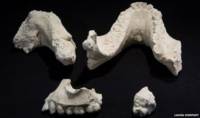- 28 May 2015
Post

In the Afar region in Ethiopia found the fossilized remains of a previously unknown species of representatives of the ancient people, according to scientists.
Researchers have found the jaw and teeth, whose age is estimated at 3.3-3.5 Ma.
This means that the new fossil species of early man lived with several other human species, which further complicates the family tree of our species.
A new species of early man called Australopithecus deyiremeda . Deyiremeda word means “close relative” in the local Afar language.
the bones are believed to be the remains of four people who had physical traits like monkeys and humans.
“We had to look at the details anatomy and morphology of the teeth and the upper and lower jaws, and we have identified fundamental differences “- told BBC BBC head of the research team Dr. Yohannas Haile Selassie, curator of physical anthropology at the Cleveland Museum of Natural History in the United States.
“This new kind of very powerful jaws. In this case, we see that his teeth are smaller. Fang is very small – less than that of fossil humans, we have described in the past,” – continued Haile Selassie.
Age remains suggests that at the same time there are four types of ancient people.
The most famous of these species – Australopithecus afarensis ( Australopithecus afarensis ). It belonged to his female fossil that scientists have nicknamed Lucy. This type lived during 3,8-2,9 years ago, and at first thought that modern man evolved directly from him.
However, in 2001 in Kenya opened another kind, called “flat-faced kenyanthropus “( Kenyanthropus platyops ), and then in Chad – Australopithecus Bahrelghazali ( Australopithecus bahrelghazali ) and here Now – Australopithecus deyiremeda . All of them could exist simultaneously.
Some scientists doubt that the found fragments of skeletons really allow us to speak about the different types; especially a lot of objections to the selection is a special kind of Australopithecus Bahrelghazali.

Dr Haile-Selassie said that the earliest stage of human evolution has been arranged to be surprisingly difficult.
“In the old days we there were no fossils, evidence of hominid diversity during the Middle Pliocene, and so we thought that there is only one line, one primitive ancestors – they believed in the name of Australopithecus afarensis Lucy – and some of it and there were all kinds of later ” – he says.
“This hypothesis linear evolution should be reviewed. We are opening more and more species found here is another. This means that the candidates for the species, from which the following types of hominids, including our species Homo, becomes more and more “, – adds Haile Selassie.
In order to understand from one of them we come, to find more fossils.
This work will also allow scientists figure out how to co-exist, these views – whether they are mixed or avoid each other, and how food and other shared resources, adds the researcher.
No comments:
Post a Comment